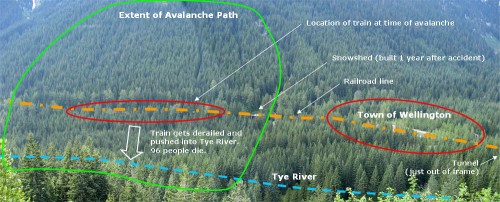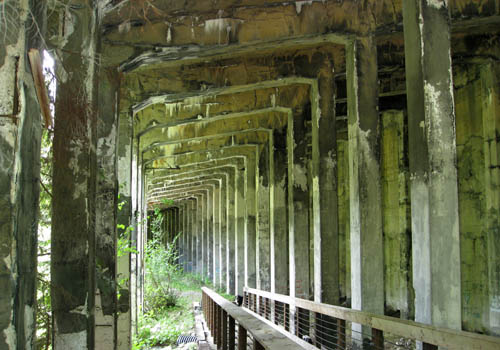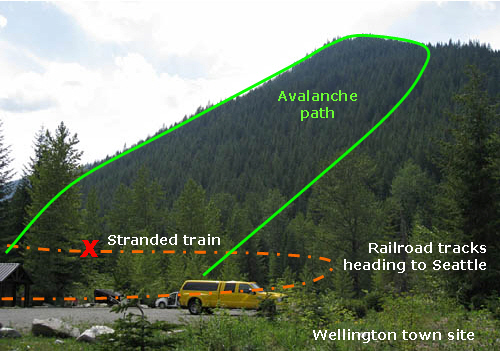America’s Deadliest Avalanche
I’d always assumed that the worst avalanche accident in America involved a remote mining town or had something to do with the Gold Rush stampede. Miners were notorious for building towns like Alta right in the middle of avalanche run-out zones, then chopping down all of the surrounding trees/anchors for firewood. If it wasn’t that, the classic old photos of hundreds of miners struggling up a mountainside all packed-in close together just screamed of a massive avalanche fatality waiting to happen. So, I was thrilled to find out the truth in Gary Krist’s 2007 book “The White Cascade: The Great Northern Railway Disaster and America’s Deadliest Avalanche.” Much to my surprise, America’s deadliest avalanche took place in 1910 and involved a train stranded just below what is now the Steven’s Pass Ski Area in the Cascade Mountains of Washington State. I had driven by this area dozens of times and after reading The White Cascade, we took a summer road trip up there to see if there was anything left of the disaster.
Although it is not clearly marked from Highway 2, the Forest Service and Volunteers for Outdoor Washington have done an excellent job preserving the disaster site and creating a handicapped friendly interpretive trail. The exit is an unmarked paved road directly across the highway from Steven’s Pass which eventually turns into a dirt road and ends at the old Wellington town site. The road is accessible by any 2wd car. Once you know where to look, the accident site is clearly visible from pull-outs along Highway 2 heading downhill.
White Cascade gives a detailed account of the events leading up to the disaster, but it can be difficult to actually envision what the avalanche site was like as there are tunnels, sidings, depot’s and other nearby towns (Scenic) which all played a part in the accident and the ensuing rescue efforts.

An annotated panorama of the Wellington disaster site taken from Highway 2.
As a brief overview, a train was crossing Steven’s Pass from Spokane to Seattle when it became stranded in a massive snowstorm at the town of Wellington. To complicate matters, a “fast mail” train was also stranded in the same small area, as well as one or two rotary railroad plows which kept breaking down. The passengers were trapped for about five days, during which time the storm intensified to a rate of up to 12″ of new snow per hour. Storm totals were in the thirteen foot range before the temperatures warmed up and, in classic Northwest style, it began to rain. There were avalanches ripping out all around them, but the passenger train itself was parked in an area which had never slid before.
Nowadays the slope is heavily forested, but prior to 1910, a forest fire had raged through the area and burned away most of the trees which helped anchor the snow. Early in the morning of March 1st, the slope released in a massive avalanche which was roughly 3,000′ wide with the stuck train right in the middle of it. The avalanche smashed the passenger cars “like an elephant stepping on a cigar box,” knocking it off the rails and down into the narrow ravine of the Tye River below. As a further kiss-of-death, the heavy locomotives folded-in on top of the passenger cars, crushing anyone who might have survived the impact of the avalanche. While a few people survived, 96 people died and it took months of work to dig out the last few bodies.

The 98 year old remains of the snowsheds built after the accident.
After the accident, Wellington was renamed Tye in an attempt to calm passengers who were anxious about passing through the Wellington disaster site. Snowsheds were added in 1911, although the ultimate fix would take eighteen years to complete and finally arrive in the form of the eight-mile long Cascade tunnel.

The tracks and the town of Wellington are long gone, but visitors can still find remnants of the concrete snowsheds and building foundations.
Both the trip to the site and the book “White Cascade” are excellent and highly recommended for avalanche geeks and non geeks alike.
______________________
For 15% off on a rainshedding Mountain Hardwear Crucial Jacket from Backcountry.com, click the jacket below…
Category: Trip Reports











wow!!!!!!!that toatally SUCKS!!!!!!!!
Hello i am a student and i am doing a project on the wellington avalanche. i was wondering if you could answer a couple questions.
-how much property was lost?
-did they do anything to prevent this from happening again?
Hi Taya – Most of what I know about the avalanche came from the book entitled “White Death” which was a great read as well as very interesting. I’ve visited the site and it appears they put up snowsheds as a stop-gap measure, but ultimately they ended up building a huge tunnel (8 miles?) to avoid all of the avalanche terrain.
Might I suggest Vis Major by Martin Burwash for a semi fictional telling of the Wellington Disaster. Bascially follows the railroad crews during the week up until the disaster. The plot is basically true, with some liberty taken in dialogue.
http://www.amazon.com/Vis-Major-Railroad-God-White-Wellington/dp/1440161798/ref=sr_1_1?ie=UTF8&s=books&qid=1263181444&sr=8-1